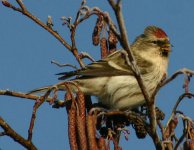SIGHTING HISTORY: The bird was initially sighted feeding on alder tree nutlet seeds on December 16, 2006 during an Iowa, USA, Chistmas Bird Count. It was observed for 30-40 minutes by two experienced birders who, due to the cooperation of the bird, had time to consult reference. The bird has remained in and near the alder trees from the 16th to present affording many photographic opportunities, with special consideration given to the undertail coverts, bill and culmen with many photo's offering an excellent gestalt of the bird. It should be noted that differing opinions as to what this bird is has prompted me to post this query.
INITIAL CLASSIFICATION; Using ABA standard diagnostic techniques which included the initial gestalt of the bird and field marks, the pair of observers classified the bird as a Common Redpoll Finch, albeit a pale one at that. Diagnostic features taken into consideration were the overall darkness of the scapulars and underlying feathers, wide wing-bar, bill length being approximately 14mm and streaking along the flanks. The red "cap" seemed posterior to classic Common, but variation of this mark occurs within the species, so this trait, while noted was not a deciding factor in determining the birds identity in the field. The distance of 1-2 mm appeared to be in the field within limits of Common. Undertail coverts appeared to have little streaking, but the observers noted winter plummage in Common (especially pale ones) often can hide this crucial identifiying field mark. Also, while cooperative, the bird offered few glimpses of this critical identifying mark.
INTRIGUE: Many people believe this bird to be an Arctic or Hoary Red Poll Finch. which is contrary to the initial field observer's conclusion. This is based largely on the photographic evidence which, taken after the initial sighting, has offered many a chance to view them at great length. Also, this bird, while not necessarily rare in Iowa during irruptive years if Common, is exceedingly rare if Arctic. Also note, this bird has been presented to the Iowa Ornithologists' Union's records committee for review, and since some observers (other than the initial) are now calling it a Hoary Redpoll Finch.
QUESTION: Since none of you will be able to see the bird in person, you will need to rely on the photographic record of the Iowa Redpoll to determine its identity. Please diagnose the bird and post your reply in detail. Please keep an open mind regardless of the title of the photograph offered in the links. I will post one thumbnail photo of which I have written permission to do, the others must be viewed via web link. Also, photographic processing, camera and lighting appear to make this bird look like more than one, but I can assure you they are all the same bird. Thank you, have fun.
This link you will need to click on ID help needed on the upper left to access the images
http://www.iowabirds.org/photo-gallery/
These links are to private nature photographer's websites
http://www.smedesphoto.com/hoary_redpoll.htm
http://www.vividpix.com/temp/Brenton_Redpoll/index.htm
INITIAL CLASSIFICATION; Using ABA standard diagnostic techniques which included the initial gestalt of the bird and field marks, the pair of observers classified the bird as a Common Redpoll Finch, albeit a pale one at that. Diagnostic features taken into consideration were the overall darkness of the scapulars and underlying feathers, wide wing-bar, bill length being approximately 14mm and streaking along the flanks. The red "cap" seemed posterior to classic Common, but variation of this mark occurs within the species, so this trait, while noted was not a deciding factor in determining the birds identity in the field. The distance of 1-2 mm appeared to be in the field within limits of Common. Undertail coverts appeared to have little streaking, but the observers noted winter plummage in Common (especially pale ones) often can hide this crucial identifiying field mark. Also, while cooperative, the bird offered few glimpses of this critical identifying mark.
INTRIGUE: Many people believe this bird to be an Arctic or Hoary Red Poll Finch. which is contrary to the initial field observer's conclusion. This is based largely on the photographic evidence which, taken after the initial sighting, has offered many a chance to view them at great length. Also, this bird, while not necessarily rare in Iowa during irruptive years if Common, is exceedingly rare if Arctic. Also note, this bird has been presented to the Iowa Ornithologists' Union's records committee for review, and since some observers (other than the initial) are now calling it a Hoary Redpoll Finch.
QUESTION: Since none of you will be able to see the bird in person, you will need to rely on the photographic record of the Iowa Redpoll to determine its identity. Please diagnose the bird and post your reply in detail. Please keep an open mind regardless of the title of the photograph offered in the links. I will post one thumbnail photo of which I have written permission to do, the others must be viewed via web link. Also, photographic processing, camera and lighting appear to make this bird look like more than one, but I can assure you they are all the same bird. Thank you, have fun.
This link you will need to click on ID help needed on the upper left to access the images
http://www.iowabirds.org/photo-gallery/
These links are to private nature photographer's websites
http://www.smedesphoto.com/hoary_redpoll.htm
http://www.vividpix.com/temp/Brenton_Redpoll/index.htm




